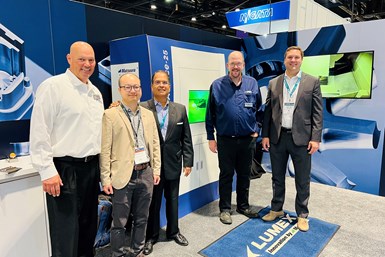Matsuura, Purdue Collaborate on Convergent Manufacturing Innovations
The partners are working to advance innovations in convergent manufacturing as researchers converge an array of processes in one platform to enable breakthroughs in manufacturing science and engineering.
Matsuura Machinery USA and Purdue University are partnering to advance a new approach to integrated additive and subtractive manufacturing for multimaterials — known as convergent manufacturing.
“Our critical partnership acknowledges a tremendous collaborative opportunity to assist North American customers with their evaluation, investigation and analysis of metal AM and, in particular, the Matsuura Lumex Series of Avance-25 machines,” says Tom Houle, director, Matsuura Lumex North America.
The collaboration combines Matsuura’s expertise in metal 3D printing and high-speed milling with Purdue’s well-known research experience. Purdue has been ranked in each of the last four years as one of the 10 Most Innovative Universities in the U.S. by U.S. News & World Report.
“Purdue mechanical engineering students have always been makers — from the earliest ‘Boilermakers’ of steam engines to the 3D printing of today,” says Eckhard A. Groll, Ph.D., head of mechanical engineering at Purdue University School of Mechanical Engineering. “Convergent manufacturing is the future of this industry, and this partnership with Matsuura shows that Purdue is committed to being at the forefront of convergent manufacturing research.”
As a result of this partnership, Purdue University will be hosting two hybrid additive manufacturing cluster tools for reactive and nonreactive materials for industries, national labs and academia.
Matsuura’s hybrid metal 3D printers are said to enable the ability to “grow” and fine mill a metal component in layers with complex internal features as the layers are added, such as conformal cooling and integrated porous venting. In most cases, it will minimize the need for traditional EDM processes and provide significant savings in the production of molded plastic components. It is said the Lumex Technology typically reduces overall build time and ensures a highly suitable surface finish. Added conformal cooling can also improve cycle times as much as 50% and mold gas venting can be optimized, the company says.
The Matsuura Lumex solution enables quick-turn prototyping, producing a wide range of parts and low- to mid-volume production runs. Products and shapes that were said to be previously impossible to manufacture (including ultradeep ribs, 3D mesh, hollows, free-form surfaces and porous structures) can now be manufactured via the Lumex platform.
Related Content
-
Nicolet Plastics Succeeds Using Mantle's Hybrid Metal 3D Printing Method for Mold Tooling
A recent webinar explores Nicolet Plastics’ success using Trueshape Technology, Mantle’s approach to print injection mold tooling. The current challenges this technology addresses and alleviates in additive manufacturing confirms this method is effectively reducing lead times and cost constraints, while producing better inserts.
-
Video: Hybrid Manufacturing Without Melting: Hermle’s Metal Powder Application (MPA) Process
The Metal Powder Application (MPA) process uses cold spray to apply metal to an existing workpiece. Because the material deforms rather than melts, MPA opens new possibilities for functional grading and other multimaterial applications.
-
JuggerBot 3D Awarded $4 Million by Air Force to Develop Large Format Hybrid Additive System
The project focuses on advancing the ability to print a thermoset composite material that can transform the way an aircraft structure is designed, fabricated and sustained for limited-life aircraft.
















